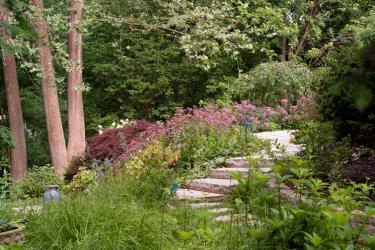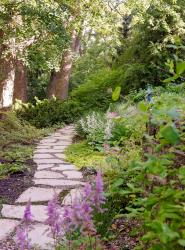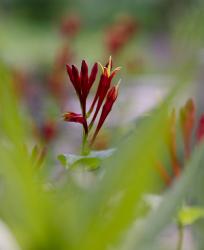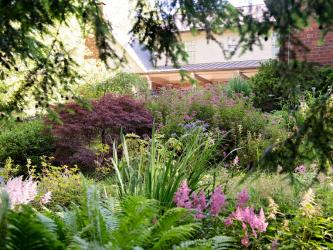There are not many gardeners who could handle the challenge of taming a two-acre, hillside landscape. But then there are not many gardeners with the talent, knowledge and dedication of Laure Hullverson. Laure holds an Associate in Applied Science in Horticulture degree from the well-regarded program at St. Louis Community College-Meramec and also has a background as an interior designer. She was the perfect person to transform an ugly, overgrown slope into a wooded wonderland that provides a haven for native plants and wildlife from a myriad of birds including owls and hawks to groundhogs, mink and an occasional newborn fawn.
It was interior design that was Laure’s main focus when she and her husband, Jim, bought their current Ladue home 16 years ago. A degree in horticulture was not on her radar. The four-year-old, brick residence attracted them, not the two-acre property with its woodsy setting.
The setting, in fact, was not much to get excited about. The property behind the house dropped off steeply to a creek below and incorporated a historic bridle trail that winds through Ladue and Huntleigh.
“The people who built the house did a nice job of landscaping around the house, but you literally could not walk down to the creek. There was so much honeysuckle. I could hear the riders, but I couldn’t see them due to the tangle of vines and junk trees,” she recalls.
For the first two years, the Hullversons concentrated on clearing the yard of honeysuckle and vines and “installing limestone slabs to allow us to get to the lower part of the property safely.” But Laure did not have a concept of what she wanted to do with the land. “I’ve always done my own landscaping,” she explains. “I grew up with a Dad who was a big gardener; it was sort of like osmosis. At my first house, I did a little gardening, and with each house I got more and more involved.”
The more involved she became in gardening, the more she wanted to know, leading her to enroll in the horticulture program at Meramec about three years after they purchased the house. At the time, she saw it as a nice complement to her interior design business, Cortinovis & Hullverson Designs with Ann Cortinovis, and a way to offer landscape design as an additional component for clients.
As it turned out, her horticultural education opened the perfect window into transforming her own property. “We really didn’t know what we were doing,” she recalls. In addition to dealing with a severe slope, “We had a lot of wet spots. I started reading a lot. It was a big learning curve.”
In the course of her research, Laure learned about Simon and Monica Barker of Barker Horticultural Services. Based in Clarksville, MO, the two have extensive horticulture backgrounds that include working at the Missouri Botanical Garden and specialize in advising clients large and small in using native plants to landscape properties. At the same time, Laure, who by then was studying at Meramec, took classes from Dave Tylka, who taught in the biology department. “They were all about natives. I discovered that a lot of the plants I liked were natives, although they weren’t marketed that way at the time, and I didn’t really understand the value of natives. We had classes during the week, and on Saturdays, we took these terrific field trips. He’s the one who provoked my interest in native plants.”
Laure’s growing love of native plants and design eye and the Barkers’ knowledge of how to incorporate them into large, challenging landscapes with hillsides, erosion issues and bog-like patches proved a dynamic combination.
Fragrant sumac now cascades down hillsides; river birch and bald cypress inhabit wet spots, and Virginia sweetspire decorates creek beds. Christmas, autumn, sensitive and ostrich ferns add lacey texture to shady spots, with Christmas fern staying green almost all year. Grass-like cattail sedge and tussock sedge form clumps in moist spots.
Laure is a particular fan of several wildflowers introduced to her landscape. One is cup plant (Silphium perfoliatum), which she describes as a yellow-flowering “Jack-in-the-beanstalk architectural plant with huge leaves that attach to the stem like cups and hold water for birds. Goldfinches love them for their seeds as well as the water.”
Another, squaw weed (Packera obovate), is a yellow-flowering, perennial ground cover that “grows in sun or shade and requires zero maintenance. My key thing is very little maintenance,” she says with a laugh.
In shady spots, she loves tall amsonia/bluestar with its gray/blue flowers in late spring and willow-like foliage that turns gold in fall.
With honeysuckle and euonymus gone, the Hullversons became the beneficiaries of a bit of garden magic that required no planting. Suddenly, myriads of spring-flowering ephemerals decorated the hillside. Virginia bluebells, trout lilies, mayapples, Jacob’s ladder and bloodroot all sprang from the ground. “They had been there under the soil all along,” marvels Laure. “Every year before the bluebells are completely finished, I take several clumps and move them to other parts of the yard so I can get patches started in other places.”
Laure is an advisor with Bringing Conservation Home, an organization spearheaded by the St. Louis Audubon Society that, for a minimal fee, provides homeowners with both large and small properties on-site advice for the restoration of native plant and animal habitat on their grounds. “It makes a real difference in the number of pollinators and birds you get. It makes gardens so much healthier,” she says.
Her garden also has been part of a bee study conducted by Webster University and St. Louis University, requiring Laure to follow the same path through her garden each week and photograph the pollinators she saw.
While Laure tries to use native plants whenever she can, she also has a deer problem in her shade-heavy landscape over hung with a canopy of oaks and hickories. For that reason, she added several deer-resistant nonnatives to her landscape such as a variety of colorful, feather-like astilbies, architectural Japanese maples and long-blooming hydrangeas.
Although Laure took the lead in the creation of the garden, Jim has been actively involved in the entire process. “It’s been really nice; it’s something we both enjoy. He loves the trees in particular,” she says.
For Laure working in the garden is “incredibly thereaputic. I was even happy being out in my yard during the weeks and weekends we spent pulling out euonymus. I love seeing things evolve. I prefer that over instant landscaping.”
When they first bought the house, “we considered the large yard a nice bonus,” Laure recalls. “Now we love the yard as much as we love the house.”

















